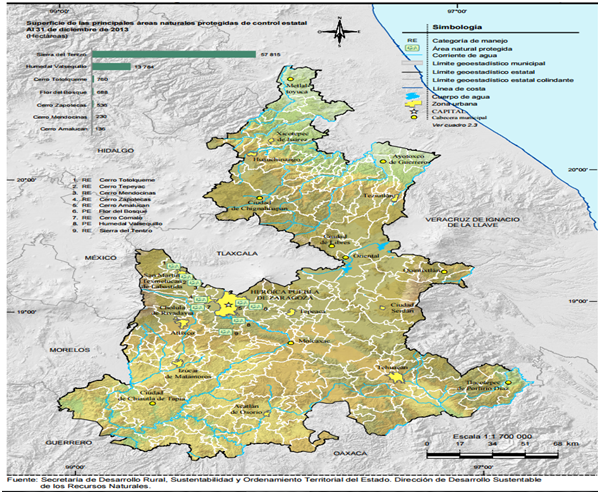Woodland diagnosis of ecological reserve "Cerro de Amalucan" in the City of Puebla, México
Main Article Content
Abstract
Trees in urban parks play a key role in the sustainability of cities. The tree is urban landscape of a city, provides environmental, aesthetic, scenic, recreational, cultural and economic benefits. The obwas to study the current state of woodland in the Cerro de Amalucan Ecological Reserve in the city of Puebla, Mexico, a forest dasometric diagnosis was applied by sampling in the area. Settling 17 sampling sites area of 1000 m2, completely randomized design with dasometric data. The results were averaged 183.5 trees per hectare, the most dominant Eucalyptus sp with 61.5% of actual stocks species. Following the species Cupressus lindleyi with 22.2%. Subsequently, the species Juniperus deppeana, with 6.8%, and the species Ipomoea murocoides, which had 2.9% of the total population, like the species polystachya Eysenhardtia, continuing the species flaccid Juniperus, with 1.6%, followed Cupressus sempervirens with 0.96%, Casuarina equisetifolia, with 0.64%, finally Pinus patula with 0.64%. Are cataloged as exotic tree species the next in line: Eucalyptus sp, and Casuarina equisetifolia, Cupressus lindleyi, Cupressus semprevirens and Pinus patula and were characterized as native species: Juniperus deppeana Eysenhardtia polystachya, Juniperus flacida. The areas are to manage 20 hectares with reforestation for restoration, on 75 hectares’ protection is carried out in areas prone to invasion and species conservation and recreation area with 40 hectares for hiking, ecological tours, bike paths and recreation.
Downloads
Article Details
References
ALANÍS, E., JIMÉNEZ, J., MORA, O. J., CANIZALES, P. y ROCHA, L. Estructura y composición del arbolado urbano de un campus universitario del noroeste de México. Revista Iberoamericana de Ciencias. 2014 1(7), 93-101.
BENAVIDES MEZA, H. M. y FERNÁNDEZ GRANDIZO, D. Y. Estructura del arbolado y caracterización dasométrica de la segunda sección del Bosque de Chapultepec. Revista Madera y Bosques [en línea]. 2012, junio,18(2), 51-71. ISSN 1405-0471. Disponible en: http://www.scielo.org.mx/scielo.php?script=sci_arttext&pid=S1405-04712012000200004
MORANDINI, R. Genética y mejora de las especies exóticas forestales. Revista de Silvicultura y Productos Forestales [en línea]. 1964, 18 (2-3), [Consultado 17 Junio 2016]. Disponible en: http://www.fao.org/docrep/03650s/03650s06.htm
MOSTACEDO, B., y FREDERICKSEN, T. S. Manual de Métodos Básicos de Muestreo y Análisis en Ecología Vegetal. Santa Cruz, Bolivia: Editora El País, 2000.
PÉREZ-MEDINA, S. y LÓPEZ-FALFÁN, I. Áreas verdes y arbolado en Mérida, Yucatán. Hacia una sostenibilidad urbana. Economía, Sociedad y Territorio [en línea]. 2015, enero- abril, 15(47), 1-33. ISSN 2448-6183. Disponible en: http://www.scielo.org.mx/scielo.php?pid=S1405-84212015000100002&script=sci_arttext
TEJADA, M., y ARÉVALO, A. Guía práctica Manejo del bosque secundario del norte de esmeraldas. Quito, Ecuador: Corporación de manejo forestal sustentable (COMAFORS), 2003


